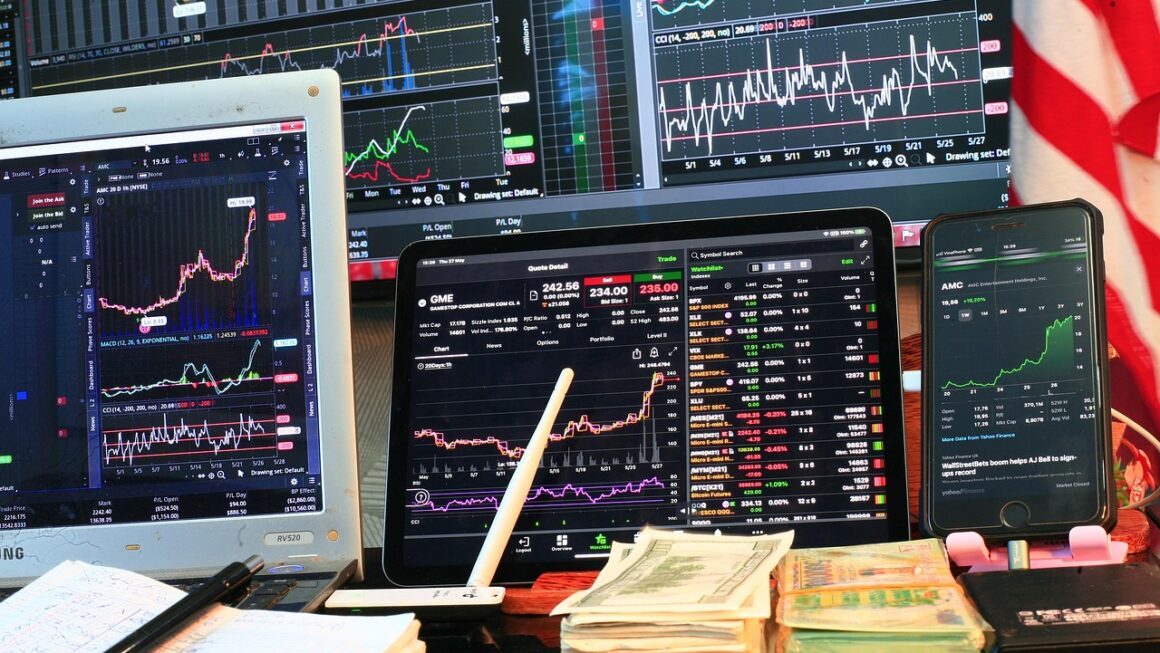Crypto futures can seem daunting, but understanding them is a key step towards navigating the complexities of the cryptocurrency market. This post will break down crypto futures trading, covering everything from what they are to how they work and the risks involved. Whether you’re a seasoned investor or just starting out, this guide aims to provide you with a solid foundation for understanding and potentially utilizing crypto futures.
What are Crypto Futures?
Definition and Purpose
Crypto futures are contracts that obligate the buyer to purchase or the seller to sell a specific cryptocurrency at a predetermined price on a future date. Unlike spot trading, where you directly buy or sell the cryptocurrency, futures trading involves speculating on the future price movement.
- Purpose:
Hedging: Futures can be used to protect existing crypto holdings from potential price drops.
Speculation: Traders can profit from correctly predicting future price movements, whether up or down.
Leverage: Futures trading allows traders to control a larger position with a smaller amount of capital.
How Crypto Futures Differ from Spot Trading
The fundamental difference lies in ownership. In spot trading, you own the cryptocurrency. In futures trading, you own a contract that represents the right to buy or sell the cryptocurrency at a specified price in the future.
- Spot Trading:
Immediate purchase or sale of cryptocurrency.
You own the underlying asset.
Limited to your available capital.
- Futures Trading:
Agreement to buy or sell at a future date.
You don’t own the underlying asset until the contract expires (if you choose to take delivery).
Leverage allows for larger positions with less capital.
- Example: You want to buy Bitcoin.
- Spot: You buy 1 BTC at $65,000. You own 1 BTC.
- Futures: You enter a futures contract to buy 1 BTC at $65,000 on a specific date. You don’t own Bitcoin immediately, but you have the right to buy it at that price on that date. If the price of Bitcoin goes up, the value of your contract increases, and you can sell the contract for a profit. If the price goes down, the value of your contract decreases, and you could incur a loss.
Understanding Key Terms
Contract Specifications
Each futures contract has specific details that traders need to understand.
- Contract Size: The amount of cryptocurrency represented by one contract (e.g., 1 BTC, 10 ETH).
- Tick Size: The minimum price increment the contract can move (e.g., $0.50).
- Delivery Date: The date on which the contract expires and must be settled.
- Settlement Method: How the contract is settled – either through physical delivery of the cryptocurrency or cash settlement. Cash settlement is more common.
Margin and Leverage
Margin is the amount of capital required to open and maintain a futures position. Leverage amplifies your trading power by allowing you to control a larger position with a smaller amount of capital.
- Initial Margin: The amount of capital required to open a new position.
- Maintenance Margin: The minimum amount of capital you must maintain in your account to keep your position open.
- Leverage Ratio: The ratio of the total position size to the margin required (e.g., 10x, 20x, 50x).
- Example: With 10x leverage, you can control a position worth $10,000 with only $1,000 of margin. While this amplifies potential profits, it also amplifies potential losses.
Mark Price and Liquidation
Mark price is an index price used to calculate unrealized profits and losses and to determine liquidation levels.
- Mark Price: A calculated price based on multiple spot exchanges. It’s used to prevent market manipulation and unfair liquidations.
- Liquidation: If your account balance falls below the maintenance margin requirement, your position will be automatically closed (liquidated) to prevent further losses. Liquidation Price is the price level at which your position will be liquidated.
How to Trade Crypto Futures
Choosing a Crypto Exchange
Selecting a reputable and reliable exchange is crucial for trading crypto futures.
- Factors to Consider:
Security: Look for exchanges with robust security measures, such as two-factor authentication (2FA) and cold storage of funds.
Liquidity: High liquidity ensures that you can easily buy or sell contracts without significant price slippage.
Fees: Compare trading fees, withdrawal fees, and other charges across different exchanges.
Leverage Options: Choose an exchange that offers the leverage ratios you are comfortable with.
User Interface: Opt for an exchange with a user-friendly interface that is easy to navigate.
Regulation: Research the regulatory status of the exchange in your jurisdiction.
Placing Orders
Understanding different order types is essential for effective futures trading.
- Market Order: Executes immediately at the best available price.
- Limit Order: Executes only when the price reaches a specific level.
- Stop-Loss Order: Triggers a market order when the price reaches a specific level, used to limit potential losses.
- Take-Profit Order: Triggers a market order when the price reaches a specific level, used to secure profits.
- Example: You believe Bitcoin will rise from $65,000.
- Long Position: You buy a Bitcoin futures contract at $65,000, anticipating a price increase. You might place a take-profit order at $67,000 and a stop-loss order at $64,000.
- Short Position: If you expect the price to fall, you can sell a Bitcoin futures contract at $65,000, anticipating a price decrease. You might place a take-profit order at $63,000 and a stop-loss order at $66,000.
Risk Management Strategies
Futures trading involves significant risk, and proper risk management is essential to protect your capital.
- Position Sizing: Determine the appropriate size of your positions based on your risk tolerance and account balance.
- Stop-Loss Orders: Always use stop-loss orders to limit potential losses.
- Diversification: Don’t put all your capital into a single trade or cryptocurrency.
- Risk-Reward Ratio: Aim for a favorable risk-reward ratio (e.g., 1:2 or 1:3).
- Avoid Over-Leveraging: Using excessive leverage can amplify losses quickly. Start with lower leverage and gradually increase it as you gain experience.
Risks and Rewards of Crypto Futures
Potential Rewards
- Profit Potential: Futures offer the opportunity to profit from both rising and falling markets.
- Leverage: Amplifies potential gains (and losses).
- Hedging: Protects existing crypto holdings from price declines.
- Portfolio Diversification: Adds another asset class to your investment portfolio.
Potential Risks
- High Volatility: Cryptocurrencies are inherently volatile, leading to rapid price fluctuations.
- Liquidation Risk: The risk of having your position automatically closed if your account balance falls below the maintenance margin.
- Leverage Risk: Amplifies potential losses.
- Market Manipulation: The crypto market is susceptible to manipulation, which can lead to unexpected price movements.
- Regulatory Uncertainty: The regulatory landscape for cryptocurrencies is constantly evolving, which can impact futures trading.
Case Study: The Importance of Risk Management
Consider a trader who uses 20x leverage to trade Bitcoin futures. They open a long position when Bitcoin is at $65,000. If Bitcoin drops by just 5%, the trader could face liquidation if they don’t have sufficient margin or a stop-loss order in place. This highlights the importance of understanding and managing leverage effectively. Conversely, if Bitcoin rises by 5%, the trader could realize a significant profit.
Advanced Strategies
Hedging Strategies
Using futures to protect existing cryptocurrency holdings from price fluctuations.
- Short Hedging: Selling futures contracts to offset potential losses from holding the underlying cryptocurrency.
- Example: You own 10 BTC and are concerned about a potential price drop. You can sell 10 BTC futures contracts. If the price of Bitcoin falls, the profits from your short futures position can offset the losses in your BTC holdings.
Arbitrage Opportunities
Exploiting price differences between different exchanges or markets.
- Cash-and-Carry Arbitrage: Buying the cryptocurrency in the spot market and simultaneously selling a futures contract.
- Inter-Exchange Arbitrage: Buying the cryptocurrency on one exchange and selling it on another where the price is higher.
Scalping and Day Trading
Short-term trading strategies that aim to profit from small price movements.
- Scalping: Making numerous trades throughout the day to capture small profits.
- Day Trading: Opening and closing positions within the same day to avoid overnight risk.
- Note: These advanced strategies require a deep understanding of market dynamics, technical analysis, and risk management.
Conclusion
Crypto futures offer a powerful tool for traders and investors looking to capitalize on the volatility of the cryptocurrency market. However, it’s crucial to understand the underlying mechanics, risks, and rewards before engaging in futures trading. By utilizing proper risk management strategies, choosing reputable exchanges, and continuously educating yourself, you can navigate the crypto futures market with greater confidence and potentially achieve your financial goals. Remember, knowledge is power, especially in the fast-paced world of cryptocurrency.




